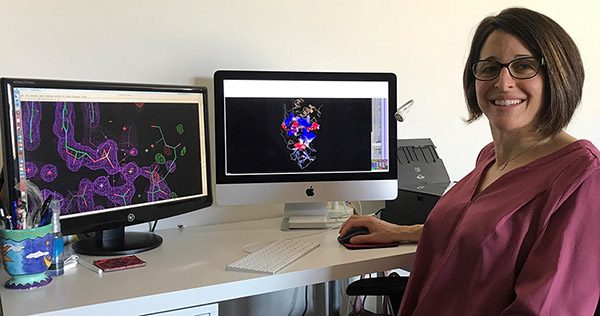Nadine Samara studies enzymes key to microbial balance in the mouth
All life on earth—bacteria at the bottom of the ocean, the hardiest desert cacti, and every human being—depends on enzymes. Through subtle shifts in shape, these proteins drive thousands of chemical reactions that cells need to grow, divide, and survive.
That such tiny molecular tweaks can broadly affect human health is a source of fascination for NIDCR
biochemist Nadine Samara, PhD. She recently earned tenure-track status through the prestigious NIH Stadtman Investigators and NIH Distinguished Scholars programs for her track record of scientific excellence and her commitment to promoting diversity and inclusion in biomedical science.
Samara studies a family of enzymes called glycosyltransferases, which help the mouth maintain a healthy balance of oral microbes. She’s trying to understand the structure and function of certain glycosyltransferases, which could be promising targets for treating oral microbial infections.
Along her journey to NIDCR, Samara was never one to choose the easy path. “I have this tendency to pursue difficult problems,” she says. For example, as a doctoral student at Johns Hopkins University, Samara took on the unusual challenge of determining the 3D structure of a cluster of enzymes and proteins that turns on RNA transcription, in which a gene’s DNA sequence is copied into RNA. Solving the structure of just one enzyme or protein is a long and intensive process. It often involves a technique called X-ray crystallography to transform proteins into crystals that are then flash-frozen and exposed to X-rays to produce images.
“My mentor said, ‘You’re a graduate student—you don’t have to work on such a big project!’” Samara says. Undeterred, Samara solved the structure of the enzyme, called Ubp8, and its three associated proteins. Her results, published in Science, shed light on how Ubp8’s bound proteins turn it on. The findings could help clarify the cluster’s role in RNA transcription and health conditions linked to defects in the process.
After finishing her PhD, Samara brought her X-ray crystallography skills to NIH, where as a postdoctoral fellow and later a staff scientist, she went on to solve the structures of multiple additional enzymes. Her postdoctoral work was supported by the National Institute of General Medical Sciences’ Postdoctoral Research Associate Training (PRAT) program, a competitive, three-year fellowship that places trainees in labs across NIH, preparing them for leadership positions in biomedical science through research, networking, and intensive career and leadership development opportunities.
Samara worked in the lab of Wei Yang, PhD, at the National Institute of Diabetes and Digestive and Kidney Disorders, studying enzymes involved in DNA replication and repair. Samara credits her strong relationship with Yang, along with the added support from her PRAT cohort, as essential to her career development.
Afterwards, Samara worked as a staff scientist in the lab of NIH Principal Deputy Director and NIDCR Acting Director Lawrence Tabak, DDS, PhD. It was there that she was introduced to glycosyltransferases, studying how structural changes to certain family members affect biological processes such as salivary gland protein secretion and colorectal cancer development.
Now as a principal investigator at NIDCR, Samara has begun assembling a research team to study glycosyltransferases in oral bacteria and their human hosts. Certain members of the enzyme family help bacteria produce sugar-based molecules that make them more infectious. In the human oral cavity, glycosyltransferases are involved in the production of mucin, which helps protect the mouth from harmful microbes. Ultimately, Samara hopes her work could help scientists identify small molecules that enhance the beneficial activities of glycosyltransferases and suppress those that are harmful to human health.
In her new role as a tenure-track principal investigator Samara draws on the values that carried her through her training, particularly the importance of a strong mentor-mentee relationship to tackle obstacles in science and in life. Studying an unfamiliar group of enzymes means the researchers have had to adopt new techniques and figure out how to apply them in the lab, a challenge Samara has embraced. “I love trying to solve scientific problems with my team,” she says.
As a mother of two young children, Samara also hopes to emulate the examples set by previous mentors in balancing science and parenthood. “I want to show my mentees that having a family is not incompatible with being a successful scientist,” Samara says. “I want them to see that it’s all possible.”
Related Links
• Stadtman Program Brings New Talent to NIDCR’s Labs
• Mentoring Is Key to New NIDCR Fellowship
References
Structural Insights into the Assembly and Function of the SAGA Deubiquitinating Module. Samara, N.L., Datta, A.B., Berndsen, C.E., Zhang, X., Yao, T., Cohen, R.E., Wolberger, C. (2010). Science, vol. 328, pp. 1025-29.
A Role for Inter-subunit Interactions in Maintaining SAGA Deubiquitinating Module Structure and Activity. Samara, N.L., Ringel, A.E., and Wolberger, C. (2012). Structure, vol. 20, issue 8, pp.1414-24.
Cation trafficking propels RNA hydrolysis. Samara, N. L., & Yang, W. (2018). Nature Structural & Molecular Biology, 25(8), 715–721.
The structure of the colorectal cancer-associated enzyme GalNAc-T12 reveals how non-conserved residues dictate its function. Fernandez, A.J., Daniel, E. J. P., Mahajan, S.P., Gray, J.J. Gerken, T.A., Tabak, L.A. and Samara, N.L. (2019). PNAS, vol. 116, pp. 20404-20410.
Attention Editors
Reprint this article in your own publication or post to your website. NIDCR News articles are not copyrighted. Please acknowledge NIH's National Institute of Dental and Craniofacial Research as the source.
Subscribe to NIDCR News
Receive monthly email updates about NIDCR-supported research advances by subscribing to NIDCR Science News.


